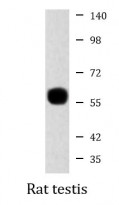ARG54117
anti-RAD9A antibody
anti-RAD9A antibody for Immunoprecipitation,Western blot and Human,Mouse,Rat,Monkey
Gene Regulation antibody
Overview
| Product Description | Mouse Monoclonal antibody recognizes RAD9A |
|---|---|
| Tested Reactivity | Hu, Ms, Rat, Mk |
| Tested Application | IP, WB |
| Host | Mouse |
| Clonality | Monoclonal |
| Isotype | IgG2b |
| Target Name | RAD9A |
| Antigen Species | Human |
| Immunogen | Purified recombinant human RAD9A protein fragments expressed in E.coli |
| Conjugation | Un-conjugated |
| Alternate Names | DNA repair exonuclease rad9 homolog A; Cell cycle checkpoint control protein RAD9A; EC 3.1.11.2; RAD9; hRAD9 |
Application Instructions
| Application Suggestion |
|
||||||
|---|---|---|---|---|---|---|---|
| Application Note | * The dilutions indicate recommended starting dilutions and the optimal dilutions or concentrations should be determined by the scientist. | ||||||
| Observed Size | 55 kDa |
Properties
| Form | Liquid |
|---|---|
| Purification | Affinity purified |
| Buffer | PBS (pH 7.4), 0.2% Sodium azide and 50% Glycerol |
| Preservative | 0.2% Sodium azide |
| Stabilizer | 50% Glycerol |
| Concentration | 4.5 mg/ml |
| Storage Instruction | For continuous use, store undiluted antibody at 2-8°C for up to a week. For long-term storage, aliquot and store at -20°C. Storage in frost free freezers is not recommended. Avoid repeated freeze/thaw cycles. Suggest spin the vial prior to opening. The antibody solution should be gently mixed before use. |
| Note | For laboratory research only, not for drug, diagnostic or other use. |
Bioinformation
| Database Links |
Swiss-port # Q99638 Human Cell cycle checkpoint control protein RAD9A Swiss-port # Q9Z0F6 Mouse Cell cycle checkpoint control protein RAD9A |
|---|---|
| Gene Symbol | RAD9A |
| Gene Full Name | RAD9 homolog A (S. pombe) |
| Background | Component of the 9-1-1 cell-cycle checkpoint response complex that plays a major role in DNA repair.The 9-1-1 complex is recruited to DNA lesion upon damage by the RAD17-replication factor C(RFC)clamp loader complex.Acts then as a sliding clamp platform on DNA for several proteins involved in long-patch base excision repair(LP-BER).The 9-1-1 complex stimulates DNA polymerase beta(POLB)activity by increasing its affinity for the 3'-OH end of the primer-template and stabilizes POLB to those sites where LP-BER proceeds;endonuclease FEN1 cleavage activity on substrates with double,nick,or gap flaps of distinct sequences and lengths;and DNA ligase I(LIG1)on long-patch base excision repair substrates.The 9-1-1 complex is necessary for the recruitment of C12orf32/RHINO to sites of double-stranded breaks(DSB)occurring during the S phase.RAD9A possesses 3'->5' double stranded DNA exonuclease activity.Its phosphorylation by PRKCD may be required for the formation of the 9-1-1 complex. |
| Function | Component of the 9-1-1 cell-cycle checkpoint response complex that plays a major role in DNA repair. The 9-1-1 complex is recruited to DNA lesion upon damage by the RAD17-replication factor C (RFC) clamp loader complex. Acts then as a sliding clamp platform on DNA for several proteins involved in long-patch base excision repair (LP-BER). The 9-1-1 complex stimulates DNA polymerase beta (POLB) activity by increasing its affinity for the 3'-OH end of the primer-template and stabilizes POLB to those sites where LP-BER proceeds; endonuclease FEN1 cleavage activity on substrates with double, nick, or gap flaps of distinct sequences and lengths; and DNA ligase I (LIG1) on long-patch base excision repair substrates. The 9-1-1 complex is necessary for the recruitment of RHNO1 to sites of double-stranded breaks (DSB) occurring during the S phase. RAD9A possesses 3'->5' double stranded DNA exonuclease activity. Its phosphorylation by PRKCD may be required for the formation of the 9-1-1 complex. [UniProt] |
| Cellular Localization | Nucleus |
| Research Area | Gene Regulation antibody |
| Calculated MW | 43 kDa |
| PTM | Constitutively phosphorylated on serine and threonine amino acids in absence of DNA damage. Hyperphosphorylated by PRKCD and ABL1 upon DNA damage. Its phosphorylation by PRKCD may be required for the formation of the 9-1-1 complex. |
Images (1) Click the Picture to Zoom In






